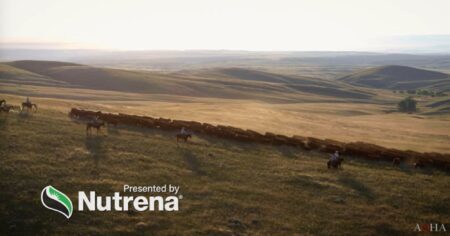By Morgan Chilson
TOPEKA, Kansas — Kansas farm income in 2025 is expected to be among the strongest in the last 20 years, bolstered by $2 billion in government payments for depressed crop prices and weather conditions, an agricultural economics expert said Tuesday.
“If you look at the inflation-adjusted farm income for 2025, it’s by far the largest we’ve seen in several years,” said Jennifer Ifft, professor and extension specialist in agricultural policy at Kansas State University. “What drove that sharp increase that we see from 2024 to 2025? The answer is government payments.”
Ifft spoke at a webinar about the outlook for farm income in Kansas and nationally, based on a report from the Rural & Farm Finance Policy Analysis Center at the University of Missouri, and Kansas State University’s department of agricultural economics.
Crop and livestock farmers face opposite market conditions, as livestock farmers are thriving amid strong demand, while crop farmers face lower prices and high input costs, Ifft said.
“We’ve seen an increase of over $5 billion in livestock receipts since 2020,” she said. “On the crop side, you have seen a decline in crop receipts since 2020. These numbers are very much moving in opposite directions, even though crops have leveled off a little bit.”
Crop receipts fell about $1.6 billion from 2020–2025, according to a chart Ifft shared. Data in 2025 is projected.
“Somebody recently reminded me that there’s never been a year when all farms are doing well, and I think that’s especially true this year, and it’s especially important to look under the hood to understand what’s happening with these numbers,” Ifft said.
Although crop farm expenses have decreased, they are still high compared with previous years, she said.
“In 2015, fertilizer expenses have come down, but they’re still 28% higher than the long-run average,” Ifft said. “Pesticides … have come down in 2025, and they’re still 30% higher than that long-run average.”
The long-run average was determined from fertilizer and pesticide expenses from 2006–2024.
Ifft highlighted government payments made in recent years, including during the first Trump administration after trade tariffs affected sales; in 2020–2021, related to the COVID-19 pandemic; and those approved at the end of 2024 to be paid this year, related to economic losses for some crop farms and disaster payments.
Gregg Ibendahl, K-State associate professor of agricultural economics, shared data that narrowed Kansas numbers down to a farm level, using information collected from farmers who are part of the Kansas Farm Management Association. He noted that in 2024, without government payments, about half of Kansas farms in his data would have lost money.
Ibendahl said the current global situation affects farm income projections.
“Some other issues to maybe think about or worry about [are] what’s going to happen with the oil supply,” he said, adding that there are wars involving two of the biggest areas in the world where oil is produced: Russia and Ukraine; and now the Middle East conflict between Israel and Iran.
“Surprisingly, though, with the fact that we have two major conflicts going on in two of the major oil-producing areas of the world, oil is still in the $70 range,” Ibendahl said. “I don’t know if the traders are being a little optimistic. They kind of got burned a little bit when the Ukraine war first started because they had jacked up oil prices into about the $130 range. Turns out that it really didn’t affect Russia’s ability to produce oil.”
If oil prices would escalate quickly, it would affect diesel and fertilizer prices, he said.
National Outlook
Kansas parallels what is happening across the country.
“The bottom line at the national level is that we are seeing short- and medium-term pain for field crops because of lower prices, sticky costs,” said Alejandro Plastina, director of the Rural & Farm Finance Policy Analysis Center. “In the cattle sector, I would say the picture is better. There are limited supplies, mostly on beef and cattle production; high prices; and lower feed costs than in the past, still high, but lower than the past.”
Plastina said government payments, specifically ad hoc payments made based on need to address situations such as weather events, were important in 2023 and 2024.
“At the aggregate level, we are projecting higher net farm income in 2025,” he said. “But there’s a lot of uncertainty regarding the impact of tariffs and trades, whether we will have a farm bill this year, reconciliation and what it will look like, and then what’s next? That’s a big question for us.”
Like Ifft, Plastina said government support from 2023 and 2024 being paid out this year will increase net farm income.
“In the absence of another round of big ad hoc, direct government payments in 2026, which there’s no sign or signal at this point that they might occur — without those payments, net farm income would decline by 20% in 2026 to be barely above what we have as an estimate for 2024,” he said.
Of the $41 billion in net farm increase predicted in 2025, $33 billion of it is in government payments, Plastina said.
“Net farm income is up for one time in 2025 for those who will receive the payments, but managing that cash flow generated in 2025 to cushion the drop in margins going forward, I think will be critical for the ag sector,” he said.
Oklahoma Voice is an affiliate of States Newsroom, the nation’s largest state-focused nonprofit news organization, supported by grants and donations. The Voice retains full editorial independence.


:max_bytes(150000):strip_icc()/52513708671_2a6075fabe_o-dcd59efb1faf4c40afb3d8f39629aa7d.jpg)

:max_bytes(150000):strip_icc()/turkeys-ars-usda-photo-4e39a75271024f29be022ff9976b4440.jpg)


:max_bytes(150000):strip_icc()/Copy-of-P5200090-a27fd34a261d43458e096c0326e904be.jpg)


:max_bytes(150000):strip_icc()/100884485_farm_grain_bin_silo-b7f811c88bdf4f078a84d89af363ddd5.jpg)
